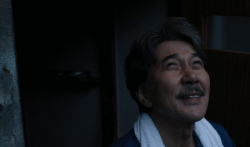The Gorillaz project is a game?a musical aside or musical footnote, an excuse for serious musicians to make less-than-serious music. Its members?2-D, Murdoc, Russel and Noodle?are cartoon characters with real-life rock star egos. Few people recognize these two important facts, but seriousness and cockiness aside, nothing can detract from their quirkiness and fun, not to mention their phat beats. The band’s Tuesday night performance at the 9:30 Club proved this beyond a shadow of a doubt.
Unlike most other concerts, a 25-foot tall horizontally-split panel segregated the band from the audience. The panel featured a hi-tech projection screen on top and semi-transparent window below through which the shadows of the band members could be seen. Fortunately for the crowd, the window periodically changed colors, spicing things up a bit.
State-of-the-art digital projectors flashed images that only occasionally corresponded with the songs being played onto the projection screen. A brief survey of the images shown would include deconstructed, pixelated b-boys executing picture-perfect freezes, monstrous royal blue gorillas from the band’s “Clint Eastwood” video and Kanji/Katakana in neon billboard font floating over dollar signs. Cutouts of 2-D, Murdoc, Russel and Noodle recurred so many times that, by the end of show, these cartoon characters had been elevated to the instantaneously recognizable status of Warhol’s Campbell soup cans. All of this was part andparcel of the Gorillaz’ satirical tribute to the globalist epoch engulfing music and the world.
But to label the Gorillaz concert as an intellectual masturbatory enterprise would be a ghastly mistake. These are not scholars of which we speak?these are “creative geniuses” (read: “spoiled kids”) bent on dominating the upper tiers of the Billboard Top 100, not winning the Nobel Prize.
Even if the primary purpose of the concert were social commentary, it would still be interesting to note the extremely positive audience response that greeted the Gorillaz?or rather, the 25-foot screen with pretty pictures on it and the occasional glimpse of the actual band. There was also the matter of the outrageous $30 admission fee. One would expect this to incite the audience, comprised of mostly wide-eyed 15-year-old girls, to riot and storm the stage rather than pump their fists in the air and shake their booties to Del the Funky Homosapien’s lyrical rhymes and Damon Albarn’s droning vocal inventions.
So what made the audience revel in front of such little substance for so long? Gorillaz banked on its MTV-constructed images as pop icons. They are Rock Stars (with a capital R), and their positions as Rock Stars far outweighed the aesthetic quality of their music. Sure, the music, which was secondary to the image, was well-anchored to funky beats, solid bass lines and Albarn’s demonically catchy tunes, but that really is all there was to it?well-crafted, highly produced pop songs.
In the end, Gorillaz is a joke, an experiment and a loud “screw you” to all the hip-hop and rock dilletantes out there who worship them because they are pop stars, not because they play good music. Take, for example, the encore of the concert: Gorillaz performed two tunes they previously played during their main set: “Slow Country” and “Clint Eastwood.” Nothing was changed. There were no alternate lyrics, no free-styling, no boring jam outros. Nothing. Yet, the concert as a whole did not skip a beat?it continued as if Gorillaz played these songs for the very first time. The crowd continued to pump their fists in the air and shake their booties without even realizing the practical joke executed at their expense.
Gorillaz said it best with the two self-referential words writ large next to cartoon figures of two pimply-faced youths with the tips of their penises hanging out of their pants: “multimedia handjob.” And that was precisely what this concert was?an 85-minute handjob, an orgasmic visual pleasure dome that overwhelmed all other elements of the concert. Despite understanding all of this, it is still impossible to not like Gorillaz, to not enjoy them, to not be sucked into the revelry.
Yet, it seems obvious that behind the pop iconography, behind the screen that hid the band’s faces from the audience, there surely looms the smiling face of Damon Albarn, laughing at the monumental joke he’s pulling on the musical world. Luckily for him, last Tuesday, the audience was laughing right along.




